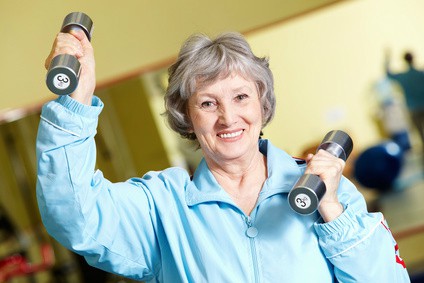Senior Fitness: Exercise and Osteoporosis

Osteoporosis is a disease which causes bones to become fragile and easy to fracture. It is a major cause of disability for older women. A fractured hip or spine impacts personal mobility and independence for a lengthy period of time. People with osteoporosis may believe they should shy away from exercise to be safe and prevent fractures. However, keeping your muscles strong and improving your balance through exercise is one of the best ways to protect your bones.
Exercise Benefits
People who have been physically active their whole lives tend to have stronger bones than people with sedentary lifestyles, but it is never too late to benefit from exercise. Being active regularly can…
- Improve balance
- Increase muscle strength
- Improve posture
- Decrease physical pain
- Improve your ability to perform daily activities
- Give a greater sense of well-being
Before you start any exercise program, consult your doctor. They may run some tests first to assess your current fitness level and take a bone density measurement.
Choosing the right kind of exercise
For people with osteoporosis, exercising means finding safe, enjoyable physical activities that make sense for their amount of bone loss and overall health. There is no perfect choice for everyone. Choosing the kind of activities you enjoy most makes it more likely youll stick with your exercise program over time.
Physical activities that are recommended for people with osteoporosis include strength training, weight-bearing aerobic exercise, flexibility exercises and stability/balance exercises.
Some kinds of exercise may be discouraged because of an increased risk of fracture. Consult with your doctor or a physiotherapist to determine what kind of risk level you are at and find out what kind of exercise is most appropriate for you.
Strength Training
Strength training exercise includes weight machines, free weights, resistance bands or water exercises to strengthen the muscles. Strength training can also help strengthen your bones directly by slowing mineral loss.
Osteoporosis can cause compression fractures in the spinal column that can lead to stooped posture. Exercises that stretch and extend the upper back and strengthen the muscles between the shoulder blades can improve your posture and help reduce stress on your bones.
Weight-Bearing Aerobic Exercise
Weight-bearing aerobics means doing an aerobic exercise while on your feet, so your bones are supporting your weight. Examples of weight bearing aerobic exercise are walking, using an elliptical trainer, dancing, stair climbing, low-impact aerobics and gardening. This kind of exercise works directly on the muscles and bones in your lower body to help slow mineral loss. They also provide cardiovascular exercise, benefiting your heart and circulatory system.
Swimming and water aerobics provide great exercise, but they dont provide the weight-bearing impact bones need to help slow mineral loss.
Balance / Stability Exercise
For people with osteoporosis, fall prevention is very important. Stability and balance training helps your muscles keep you stable and reduce your risk of falling. Simple exercises like Tai Chi, or even practicing standing on one leg, can improve your balance.
Flexibility Exercises
Having a full range of motion for all your joints helps you maintain good balance and prevent injury. People with osteoporosis should avoid stretching exercises that involve bending at the waist or flexing the spine. Stretches should be done after your muscles are warmed up, and should be done gently and slowly, without bouncing. Consult with your doctor to determine which stretching exercises would be appropriate for you.
Exercise to avoid
People with osteoporosis should avoid high-impact exercise involving running, jogging or jumping as this could lead to fractures. Any activity involving rapid movements should be avoided. Slower, controlled movements are the safe choice.
Exercises that involve bending and twisting, like sit-ups or toe touches, can increase the risk of compression fractures in the spine. Other physical activities that might involve bending and twisting are bowling, golf, tennis and yoga.
If you have osteoporosis, talk to your doctor about how healthy your bones are. Fearing a fracture shouldnt keep you from being active.
More questions?
Want to speak to a care expert about how to ensure the safety of your loved one during these uncertain times?
Let's connect you with the closest available Qualicare expert in your city to answer your questions.
The Qualicare Difference
Comprehensive care planning led by experienced Care Experts
"Qualicare changed everything. Mom loves her new companion, meanwhile Jack and I have peace of mind and more time to focus on the kids. "
Janette Aldermaine


 Have Questions?
Have Questions?